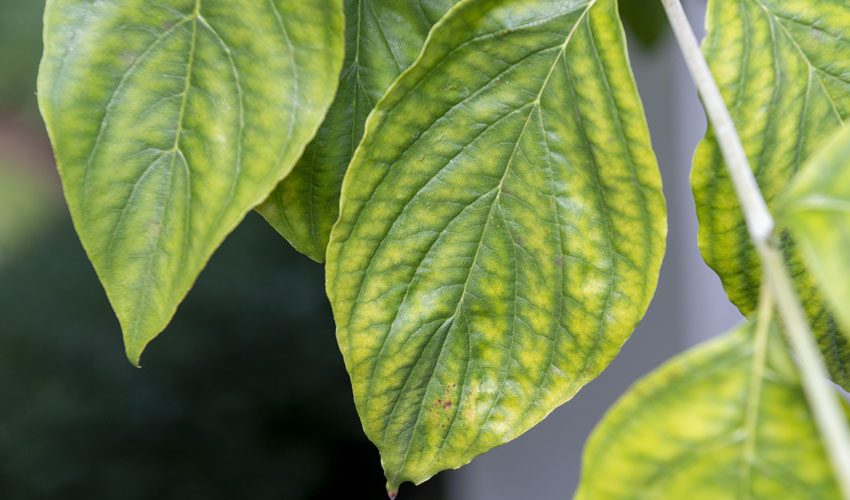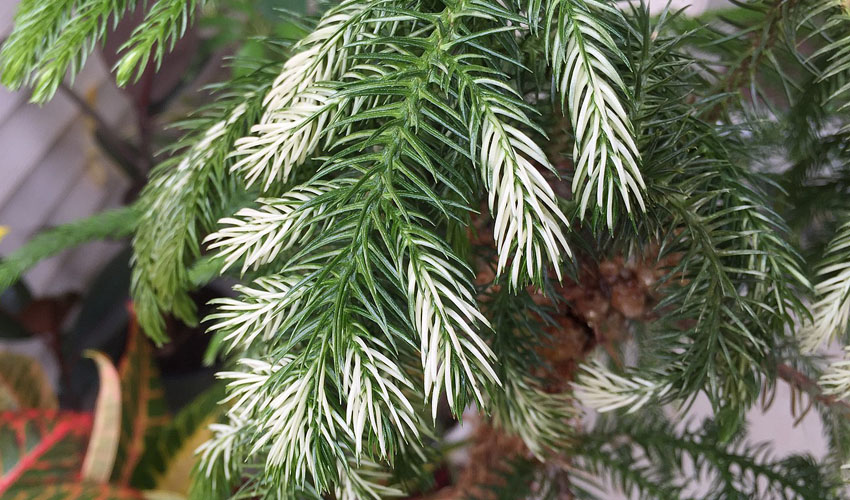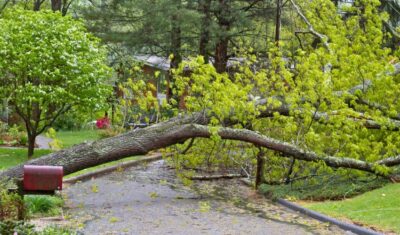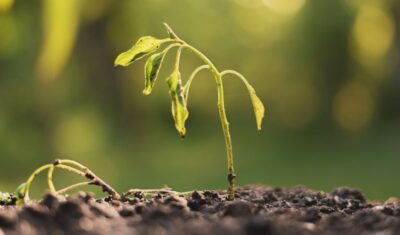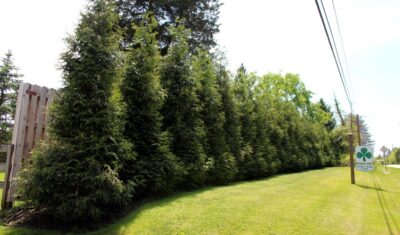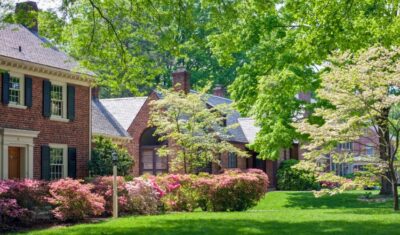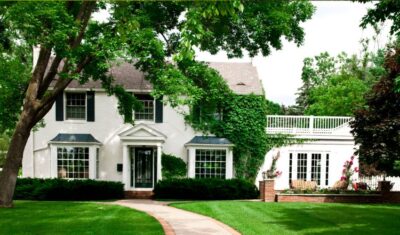In northeast Ohio, we normally expect to see trees covered in yellow leaves in fall. During other times of the year, however, yellow leaves on your trees can mean something’s wrong. If you’re doing everything right and can’t figure out the problem, it might be chlorosis. Read on to learn about the symptoms and causes of chlorosis, and what remedies are available.
What is chlorosis?
Chlorosis is the yellowing of leaves caused by a lack of chlorophyll. Chlorophyll is the “green” that trees synthesize from sunlight’s energy and the water and nutrients taken up by a tree’s root system. It’s what makes tree leaves green.
Green leaves turn yellow (become chlorotic) when a tree takes up too few mineral nutrients and doesn’t synthesize enough chlorophyll.
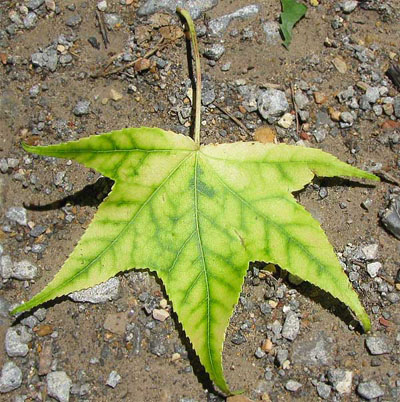
A sweetgum leaf showing clear signs of chlorosis
What causes chlorosis?
Several things can cause trees to take up fewer mineral nutrients and produce insufficient amounts of chlorophyll. In northeastern Ohio, this leaf yellowing may occur because of:
- Nutrient deficiencies in the soil
- Root damage (for example, from nearby construction)
- Compacted soil
- Poor drainage or overwatering that leaches nutrients
- Excessive levels of organic matter
- Pest damage
- Herbicide use
Does chlorosis damage trees?
Because chlorosis stresses trees, reduces their energy stores, and damages their leaves, it’s a good idea to find the source and treat it. If chlorosis is left untreated, it results in:
- Stunted growth
- Low flower and fruit yield
- Increased susceptibility to pests and diseases
What does chlorosis look like?
Yellowing leaves are the main symptom of chlorosis – but leaf yellowing is also a symptom of other problems (such as heat stress and nutrient deficiencies). It’s how those leaves turn yellow that provides a clue about whether it’s chlorosis or something else.
When we say “chlorosis,” we're generally talking about iron deficiency, a nutrient deficiency that causes leaves to yellow in a particular way. Iron chlorosis is “interveinal,” meaning the yellowing occurs in leaf tissue between the leaf’s veins. Those veins stay green, and it’s this symptom that identifies iron chlorosis in shrubs and trees.
What other deficiencies can cause yellowing leaves?
- Nitrogen deficiency causes mostly older leaves to yellow. With limited nitrogen, a shrub or tree will send what nutrients are available to support new leaf growth. As a result, older foliage gets fewer (or even no) nutrients.
- Magnesium deficiency also affects the leaf tissue between leaf veins, but areas of leaf tissue may turn bronzy-orange as well as yellow.
- Potassium deficiency shows yellowing similar to other deficiencies but often includes leaf curling and scorching at the leaf’s margins.
- Other nutrient deficiencies, such as zinc, sulfur, and manganese also make particular leaf-yellowing patterns that help tree-care professionals diagnose chlorosis.
If you’re not sure whether your tree’s yellowing leaves are due to iron chlorosis or something else, give us a call. Our ISA Certified Arborists will be able to diagnosis the problem and recommend a solution.
Why do some trees not get enough iron?
With iron chlorosis, the problem may not be a lack of iron in the soil, but the tree’s inability to take up iron from the soil. This is the case when a soil’s macro- and micronutrients are all present, but the pH of the soil has affected the soluble availability of mineral nutrients.
What does pH mean?
A soil’s pH is an indication of its acidity or alkalinity. The pH scale runs from 1 to 14, with 7 being an optimal balance (neutral) and a pH range from 5.5 to 7.5 being the best pH range for growing the widest variety of shrubs, trees, and crops. In northeast Ohio, most trees that grow in our hardiness zone will grow well with a pH of 6.8 and consistently moist but well-drained soil.
Depending on a region’s geologic history and its climate some native soils are naturally more acidic or alkaline. Plants that are native to a given region have evolved to grow in these native soil conditions.
For example, red maple and pin oak are common trees that prefer acidic conditions – and often develop chlorosis in our more alkaline, urban environments. In contrast, Ohio’s buckeye (Aesculus glabra) likes a higher, more alkaline soil pH.
So how does soil pH cause chlorosis in my trees and shrubs?
A soil’s pH determines how available soluble mineral nutrients are for trees and shrubs to use.
When a soil’s pH is more acidic (a lower pH number) or more alkaline (a higher pH number) than the optimum range, it can affect the availability of soil nutrients. The pH changes nutrients in the soil to make them more or less soluble in water. If they’re not soluble, those nutrients are less available for roots to take up.
In more alkaline soils (higher pH), iron becomes unavailable for absorption, resulting in iron deficiency and chlorosis.
Many plants and trees have evolved to grow in their native soil and its natural pH. When they’re planted in soil with a different pH, chlorosis can be an ongoing problem.
Is there a way to treat chlorotic plants?
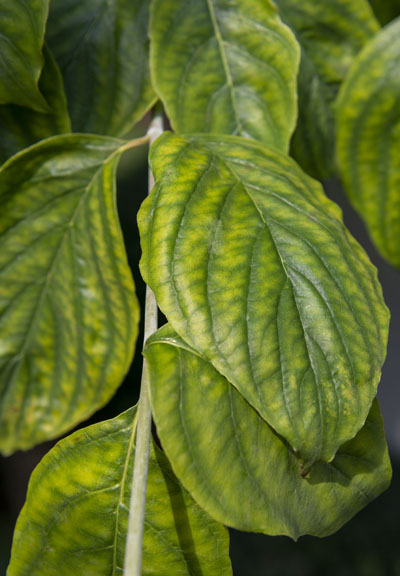
Chlorosis on dogwood leaves shows up as dark green veins on a light green leaf
There are several ways to treat chlorosis. Note that none of these are “cures” and treatments will have to be repeated. This is because there’s no practical way to make large-scale soil-type changes to adjust the pH level throughout your property. And because water naturally moves through soil, localized nutrient supplements will constantly be washed away.
This is why our first suggestion isn’t about treating chlorosis – it’s about preventing it in the first place. Plant native or adapted species. The easiest way to ensure the long-term health of your trees and shrubs is to choose ones that are adapted to your soil's pH.
If you have trees and shrubs that are not native, or that need more of certain mineral nutrients than your soil’s pH can provide, there are several treatment options:
- Apply elemental sulfur to your soil to reduce soil pH
- Apply chelated iron to your soil to increase available iron (chelates are naturally occurring chemicals that help prevent mineral leaching)
- Inject tree trunks with iron sulfate
- Spray foliage with iron sulfate or chelated iron
Always apply these treatments at levels and intervals that are tailored to your soil’s pH and the needs of your trees and shrubs. And remember that each of these methods has its own benefits and shortcomings (particularly when applied incorrectly). For example:
- Foliar iron sprays can burn leaves when applied during hot weather
- Iron sprays and granules can stain concrete
- Foliar and supplemental iron treatments are short-lived
- Treating the soil around individual plants is time consuming and requires regular reapplications
- Trunk injections need to be precise and injection holes can damage trees
All treatments should be done by professionals. Ideally, a soil test and foliar tissue sample will both be done first to determine which treatment method will produce the best results and how much to use. Tree care professionals also understand the best timing for each type of treatment and how a tree or shrub is likely to respond.
Independent Tree offers a range of options to prevent and treat chlorosis in your trees and shrubs. Give us a call at 440-564-1374 for an inspection and free estimate!
Can I prevent chlorosis from developing in my trees and shrubs?
One of the best long-term solutions to avoid chlorosis problems is to amend your soil with compost. This will help ensure your soil’s pH is at a level that’s beneficial for your plants and trees.
Apply a one-inch layer of organic compost and add three or more inches of organic mulch atop the compost. This simple step is an effective method for long-term soil improvement. Compost will break down into your soil and bond to its particles, improving the soil’s structure, its water-holding capacity, and its levels of available mineral nutrients.
NOTE: When you amend your soil, don’t overdo it with manure or other high-phosphorous amendments. High levels of phosphorus in soil can make your iron chlorosis worse. High phosphorous levels can also make soil nitrogen unavailable, and cause stunted plant growth.
What if I can’t adjust my soil’s pH to provide the amount of iron my plants need?
Be philosophical about your plant choices. Working with, instead of against, your native soil will yield better long-term results and reduce the time and money you’ll need to spend to keep your garden healthy. This doesn’t mean leaving poor or depleted soil as it is. Rather, it means working within the natural range of your healthy soil’s pH.
If you have particular plants that you can’t do without, consider grouping them in one area of your garden or growing them in containers. That way, you can better adjust the soil’s pH in that one area to match their needs, or use different container planting mixtures to achieve the desired pH.
GIVE US A CALL
If you’re seeing signs of chlorosis in your trees and shrubs, give us a call. We’ll come by and evaluate just what’s going on, and design a program that addresses your garden’s particular needs. Our goal is to ensure your enjoyment of your property by ensuring the long-term health of your plantings.
Are Your Tree Leaves Turning Yellow?
If you notice yellowing leaves on your trees, they may be suffering from chlorosis. Contact Independent Tree to schedule a tree inspection.Recent Articles
Topics
About The Author

STAY IN THE LOOP
WITH OUR
LATEST UPDATES
"*" indicates required fields

